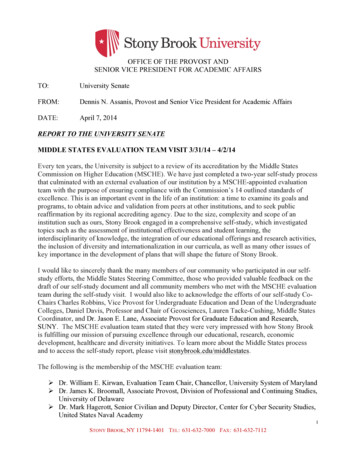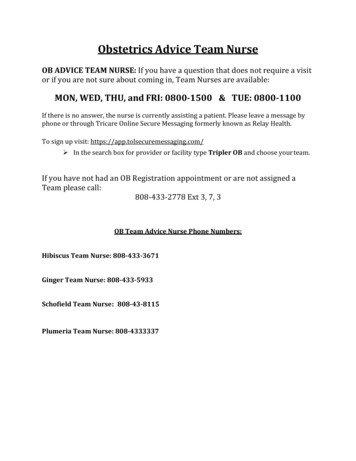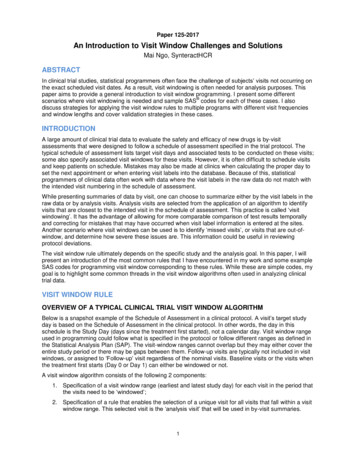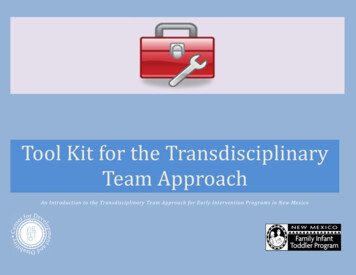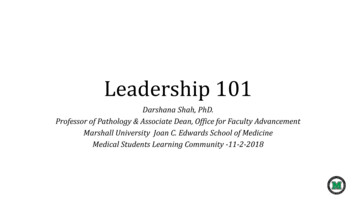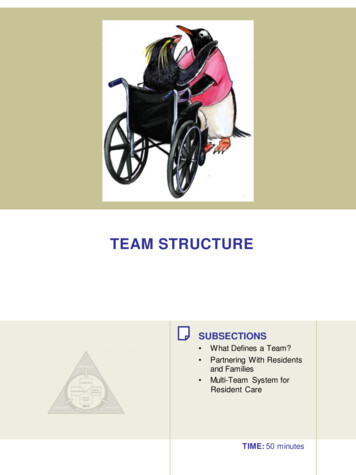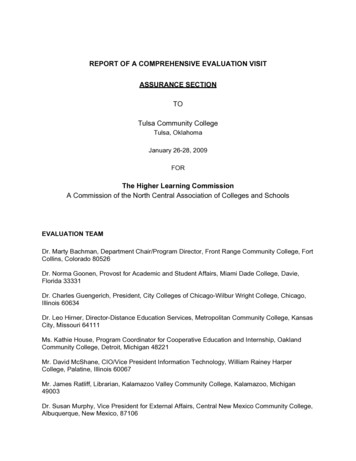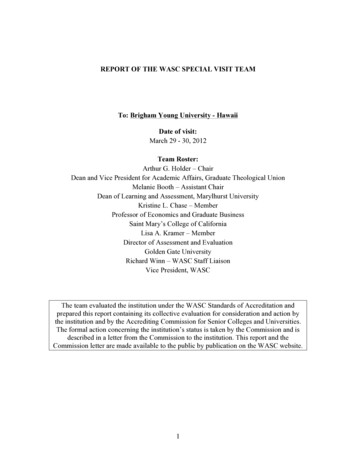
Transcription
REPORT OF THE WASC SPECIAL VISIT TEAMTo: Brigham Young University - HawaiiDate of visit:March 29 - 30, 2012Team Roster:Arthur G. Holder – ChairDean and Vice President for Academic Affairs, Graduate Theological UnionMelanie Booth – Assistant ChairDean of Learning and Assessment, Marylhurst UniversityKristine L. Chase – MemberProfessor of Economics and Graduate BusinessSaint Mary’s College of CaliforniaLisa A. Kramer – MemberDirector of Assessment and EvaluationGolden Gate UniversityRichard Winn – WASC Staff LiaisonVice President, WASCThe team evaluated the institution under the WASC Standards of Accreditation andprepared this report containing its collective evaluation for consideration and action bythe institution and by the Accrediting Commission for Senior Colleges and Universities.The formal action concerning the institution’s status is taken by the Commission and isdescribed in a letter from the Commission to the institution. This report and theCommission letter are made available to the public by publication on the WASC website.1
TABLE OF CONTENTSSECTIONPAGESECTION I: OVERVIEW AND CONTEXT3A. Description of the Institution and Visit3B. The Institution’s Special Visit Report: Quality of the Report andSupporting Evidence5C. Description of the Team’s Review Process6SECTION II: EVALUATION OF ISSUES UNDER THE STANDARDS7A. Issue: Financial Priorities7B. Issue: Assessment of Student Learning14C. Issue: Faculty Scholarship18SECTION III: FINDINGS AND RECOMMENDATIONS22APPENDIX – Credit Hour Worksheet252
SECTION I. OVERVIEW AND CONTEXTA. Description of the Institution and VisitBrigham Young University-Hawaii (BYU-Hawaii) is a small comprehensiveuniversity located in Laie, Hawaii. Owned and operated by the Church of Jesus Christ ofLatter-Day Saints (LDS Church), BYU-Hawaii was founded in 1955 as a two-year schoolknown as Church College of Hawaii. It became a four-year school in 1961 and receivedits present name in 1974.BYU-Hawaii is part of a three-campus system governed by a Board of Trusteeswho are general officers of the LDS Church; the other institutions are BYU-Idaho andBYU-Provo. The university’s mission is “to integrate both spiritual and secular learning,and to prepare students with character and integrity who can provide leadership in theirfamilies, their communities, their chosen fields, and in building the kingdom of God.”The student body at BYU-Hawaii comprises 2,784 undergraduates from 78 differentcountries, with 49.5% coming from the Asia-Pacific area (including Hawaii), which is theuniversity’s primary mission area. Many students (42.6%) are international, with 37.8%coming from the university’s international Asia-Pacific target area. In fall 2011 therewere 124 full-time and 126 part-time faculty. IPEDS data from 2010-11 showed anoverall student/faculty ratio of 16.8.Since the Educational Effectiveness Review (EER) in 2008, the university’sacademic departments have been reorganized into four colleges of approximately equalsize (Business, Computing and Government; Human Development; Language, Cultureand Arts; Math and Sciences) offering a total of 25 different majors leading to thedegrees of BA, BS, BFA (Fine Arts) and BSW (Social Work). In October 2009 the3
WASC Commission approved proposals for two new degree programs: an Associate ofArts and Science, and an Associate of Science in Business Management. The school’s2011-12 catalog also describes a new Bachelor of University Studies degree that wasreported to WASC in 2009 but was not mentioned in the institution’s Special VisitReport.BYU-Hawaii has been accredited by WASC as a four-year institution since 1961.The last accreditation cycle concluded in June 2008 with the Commission’s action toreaffirm accreditation, schedule a Capacity and Preparatory Review for spring 2017 andan Educational Effectiveness Review for fall 2018, and require a Special Visit in spring2012 regarding three issues:1) Financial Priorities: Ensuring that the institution’s newly articulated imperatives(to increase the overall quality of education, and increase total number of studentswithout additional church funding) have not compromised educationaleffectiveness in terms of their impact on class size, faculty recruitment, facultyresearch, use of online instruction, and continued support for assessmentactivities.2) Assessment of Student Learning: Continued work on assessment, includingcomplete implementation of appropriate student learning outcomes, programreview for all departments, assessment of general education competencies, anduse of assessment data to improve learning.3) Faculty Scholarship: Continued development of the definition of faculty standardsfor various forms of scholarship such as those identified by Ernest Boyer4
(discovery, integration, engagement, teaching), and the implications of thoseclarified standards for faculty retention, development, and promotion.B. The Institution’s Special Visit Report: Quality of the Report and SupportingEvidenceThe Special Visit Report submitted by BYU-Hawaii was appropriately organizedin relation to the three concerns expressed by the WASC Commission. The report itselfwas primarily presented in narrative format, describing actions taken since the EER visitand reporting on conclusions drawn from assessment activities and the institution’s selfanalysis. Supporting documentation was presented in twelve appendices and six tables,supplemented by an extensive array of materials made available to the team on theschool’s website (and for the most part readily accessible to the general public).The team was informed that the principal authors of the report were the AssociateAcademic Vice President with responsibility for Institutional Effectiveness (who is alsothe Accreditation Liaison Officer), the Director of University Assessment and Testing,and the chair of the Faculty Advisory Council. Other administrative and academic leaderscontributed information for the report, which was reviewed by the President’s Council,Academic Council, Faculty Advisory Council, and Institutional Effectiveness andAccreditation Steering Committee.Nearly a third of the report was devoted to an account of the currentadministration’s initiatives to improve the quality of teaching and learning, decreasecosts, and increase the number of students served. The team found this backgroundinformation helpful in understanding the very significant changes that BYU-Hawaii hasmade in the last four years. At the same time, the team noted that some of the changes are5
still quite recent, and others are not yet complete. For example, between 2008 and 2010,total FTE enrollment grew from 2,269 to 2,740 (an increase of 21%). The universityplans to add more than 2,000 additional students over the course of the next several years.As a result, the school’s evaluation of the effects of those changes is at this stagenecessarily preliminary.C. Description of the Team’s Review ProcessThe team received the Special Visit Report on February 7, 2012 and discussed iton a conference call on February 21, 2012. While on campus for the Special Visit onMarch 29-30, the team met with the President (by videoconference), Academic VicePresident, Vice Presidents for Administration and Construction and FacilitiesManagement, President’s Council, Institutional Effectiveness and AccreditationCommittee, Academic Council, University Assessment Committee, Faculty AdvisoryCommittee, General Education Committee, and small groups of representative facultyand students. The team was also able to examine some additional documentation madeavailable by the institution such as the Master Plan for facilities development and a tenyear projection of enrollment, personnel, and budget figures. The team appreciated theprofessionalism and attention to detail that was evident throughout the school’spreparation for the visit, and the generous hospitality extended to them during their timeon the university campus.6
SECTION II. EVALUATION OF ISSUES UNDER THE STANDARDSA. Financial PrioritiesIn its June 2008 Action Letter, the Commission identified financial priorities as anarea of concern. At that time, BYU-Hawaii had just been reminded by the LDS Churchthat the benefaction from the Church should be reduced to 70% of operating costs from alevel of over 80%. At the time of the EER visit, BYU-Hawaii was considering a numberof specific strategies to reduce operating costs and the need for support from the LDSchurch. These strategies included increasing student-faculty ratios and class sizes, usingmore online delivery of courses, and reducing support for faculty research. TheCommission observed the following: “it is unclear how the institution will balance thesefinancial priorities without compromising its historically strong educational experiencefor underserved and financially limited students (CFRs 1.1, 1.2, 1.3, and 3.5). Theinstitution will need to demonstrate that it can, in fact, strike an effective balance betweenthese potentially competing priorities.” In response, the Special Visit Report specificallydetailed, as listed below, some of the various strategies now being used to reduce LDSchurch costs per student. A new Master Plan includes the goal of doubling the size of BYU-Hawaii overthe next ten years. The principle driving the plan is that a larger institution canachieve economies of scale in several areas, as well as broaden its missionoutreach. The academic calendar has been compressed from two semesters and two summerterms to three semesters (fall, winter, summer). Most students are required to7
complete their education within nine semesters, and the University is able to useits facilities and staff more efficiently. A "culture of stewardship" has been developed, evidenced by an academic andadministrative reorganization as well as institution-wide budget reductions and atemporary hiring freeze (now expired) for non-faculty employees, among otherspecific initiatives. Tuition has been raised over 20% since 2007-08 (not including an adjustment forhealth insurance now being packaged with tuition). Online courses have grown exponentially from the last visit and now comprise10% of all credit hours taken by both on-campus and distance students. Faculty contracts have been redesigned so that the increase in courses taught eachacademic year is covered by overloads paid at a lower per course rate. Thisarrangement (required for faculty not in continuing status and optional for thosewho are) enables faculty to augment their annual income and the University toreduce costs.Addressing Commission concerns that the above strategies might negatively impact themission of the institution and quality of the educational experience, BYU-Hawaiiprovides in the Special Visit Report various types of evidence that it not only issuccessfully pursuing its mission using the above strategies, but is also expanding it.Applications to BYU-Hawaii have risen significantly, cumulative GPAs have not beenimpacted by the compressed calendar, and there is some evidence that the marketabilityof BYU-Hawaii degrees continues to improve (a particularly important goal for theinternational students). Financial aid has increased in dollar terms, keeping up with the8
increased enrollment. The online courses have made access to a BYU-Hawaii degreeeasier for international students and the Report provides assessment results showing thatthe online English courses have not negatively impacted the English languagecompetency of international students.During the visit, the team focused on obtaining additional evidence that BYUHawaii was continuing to achieve both its financial and mission-based priorities. Theteam reviewed the last two years’ audited financial statements as well as data exhibitsprovided with the report, which revealed student/faculty ratios, class size, facultycomposition (full-time and part-time), and student learning. Overall, the team’simpression is that BYU-Hawaii is an institution that is financially healthy, but isundergoing a significant transition in its financial profile that has created some challenges(CFR 3.5). As BYU-Hawaii notes in the Report, this is a situation not unlike thatexperienced by many institutions during the recent financial crisis. The team recommendsthat as BYU-Hawaii continues to implement its plan for enrollment growth, it pay carefulattention to the effect on the institution’s culture of stewardship, intimate sense ofcommunity, and ability to meet the emerging needs of its students, staff, faculty, andfacilities.BYU-Hawaii’s Special Visit Report acknowledges that the changes have notcome without stress on the faculty, staff, and students. As noted below, the team foundthat some of the strategies to reduce expenses have had serious, though perhapsunintended, consequences. Of particular concern to the team was the impact ofcompressing the academic calendar. Reflecting good practice, BYU-Hawaii conductedcareful surveys of faculty and students about the new calendar (CFRs 4.6, 4.7). Survey9
responses from students were mixed at best, and faculty expressed significant concernover their ability to present academic material effectively. In response, BYU-Hawaii hasagain revised the calendar, with the new version to start in winter 2012. However, thebasic compressed structure remains, and it clearly has had significant impact on theability for the BYU-Hawaii student population to successfully complete the existingcurriculum. A key reason for this impact is that, in order to induce students to finish theirstudies expeditiously and make room for new students to benefit from the educationalmission, BYU-Hawaii now requires students to finish their degrees within nine semesters(including at least one summer semester) over four years (three years for those on theIWORK financial aid program). Students can petition for an exception to be allowed anadditional semester to complete their studies, in which case they are still eligible forcampus housing and financial aid. Though many students may be able to comply with theabove restrictions, this is particularly difficult for international students who make upapproximately 50% of the student population. Those students who participate in theIWORK program are obligated to work 19 hours/week during terms, and 40 hours/weekbetween terms.The team recommends that BYU-Hawaii re-evaluate the 9 semesters in residenceacademic model to ensure that the compressed and accelerated learning format is actuallyserving the student population. Currently, the rigidity of the structure significantlyconstrains students’ options, potentially negatively impacts student learning andpreparedness, and appears to be contradictory to the BYU-Hawaii Framework for StudentLearning. Furthermore, the team recommends that BYU-Hawaii ensure that bothprospective and current students are better informed through advising processes about the10
need for careful academic planning in addition to the rationale for curricularrequirements. The combined effect of the compressed calendar, the need for students towork substantial hours, a lack of communication and support for careful degree planning,and students’ varying levels of preparation prior to entry has resulted in a considerablenumber of students who have been unable to successfully finish their declared majorprograms.In order to provide a way for such students to graduate with a degree, BYUHawaii has created a “Bachelor of University Studies” degree. This degree is not basedon a traditional academic program, but on the completion of 120 credit hours, with only aloosely defined structure requiring 12 credits in each of two or more “clusters” (which arenot defined) or minors. As the team heard it described by a senior academicadministrator, the degree was designed as an “exit strategy” for students who arechallenged by the new calendar and completion restrictions. As of the visit, this degree isnow the second most-awarded degree at BYU-Hawaii, comprising 9% of degreesawarded in the 2010-11 academic year.The team believes that the University Studies degree, though not officiallypresented as part of the current financial strategy, is an ill-conceived attempt to deal withsome of that strategy’s unintended negative effects on student success rates. When theteam asked senior administrators and faculty leaders about the process by which the newdegree was developed, the response was that it had been proposed and quicklyimplemented by academic administration without extensive faculty consultation (CFR2.4). Based on the minimal half-page description of the program in the university’scatalog and interviews with academic administrators and faculty during the visit, the team11
is very concerned that this degree program is not clearly defined in terms of levels ofstudent achievement necessary for graduation that represent more than simply anaccumulation of courses or credits (CFR 2.2), does not require students to engage in anin-depth, focused, and sustained program of study (CFR 2.2a), and does not requiresignificant study in depth in a given area of knowledge (guideline for CFR 2.2a). Sincethis new degree is not associated with any particular department or supervising academicunit and does not comprise a coherent set of course requirements, it would be virtuallyimpossible to develop assessable outcomes for this degree (CFR 2.3).In addition, during the visit, students and faculty expressed deep concern aboutthe academic integrity and rigor of this degree, which they described as a kind of“consolation prize” for students whose advisors judged them incapable of completing therequirements of a departmental major, or who could not afford to finance an additionalsemester if needed to complete their programs, or who did not receive adequateadvisement concerning the careful selection of courses necessary for them to completetheir intended major within the nine semester limit. Nearly all of the faculty and studentsinterviewed by the team expressed a fear that the Bachelor of University Studies was a“worthless degree” that would not be appreciated by potential employers and that wouldover time devalue the reputation of the entire school.Based on the above information, the team strongly recommends that if theBachelor of University Studies is to be continued, BYU-Hawaii should demonstrate thatthe implementation of this degree program provides for:12
1) Clear definition of the expected level of student achievement and requiresengagement in an in-depth, focused, and sustained program of study (CFR2.2);2) Clearly stated student learning outcomes and expectations for studentattainment at the program level (CFR 2.3);3) A plan for systematic program review including analyses of theachievement of the program’s stated student learning outcomes, programretention and completion, and evidence that graduates are beingeffectively prepared for future employment or further study (CFR 2.7);4) A designated core of faculty who exercise oversight over the design,delivery, review, and improvement of this degree program (CFR 2.4).The team identified two additional concerns that will require ongoing assessmentby both the institution and by future WASC teams. The first is the sustainability of the"culture of stewardship." Many of the cost reduction initiatives have increased stresses onboth faculty and students. New full-time faculty are required to carry the augmented load,and the impact of this increased teaching expectation will not be seen until these facultycome up for review for continuing faculty status and eventual promotion. While BYUHawaii notes that current faculty continue to participate in professional development,those same faculty have, on average, a lower teaching load (CFRs 3.3, 3.4). Further, asmentioned earlier, international students continue to be required to work 19 hours a weekin the IWORK program.The third concern for future assessment is the new Master Plan, which proposesincreasing enrollment to 5,000 as well as a very significant expansion of the physical13
plant. Though the Special Visit Report notes the importance of this new direction, and theUniversity has developed a matrix showing the basic forecasts for key operationalbenchmarks over the next ten years, there is still little in the way of specific plans for howBYU-Hawaii is going to accommodate such rapid growth. The details of the plan, interms of student support, staffing, facilities, financial goals, etc. should already be inplace, given the University's trajectory at the moment (CFRs 4.2, 4.3).Just as importantly, BYU-Hawaii needs carefully to consider the potential impacton campus culture of a doubling in size of the student body. Throughout the visit, theteam was impressed by faculty and student comments that emphasized the value of closepersonal interactions between faculty and students. A question for the institution iswhether this culture can be maintained with a much larger population and physicalenvironment.B. Assessment of Student LearningIn its Commission Action Letter dated June 30, 2008, the Commission requested thatBYU--Hawaii consider the following with respect to its assessment and program reviewwork:1) Sustain work in assessing critical thinking and writing skills within the GEcurriculum and extend the work to cover other core competencies;2) Renew efforts to deploy assessment at a uniformly high level across alldepartments and units (with the Commission noting that some initiativesmay have experienced a loss of focus and momentum since 2006);3) Ensure key assessment findings are integrated into program or unitreviews;14
4) Develop a systematic process for incorporating results from programreviews into departmental planning and into strategic planning structuresas appropriate; and5) Strive to ensure assessable learning outcomes are included in coursesyllabi.A review of the Special Visit Report, an examination of annual assessment andprogram review reports and syllabi, and discussions with the Assessment Committee, theGeneral Education Committee, and faculty and staff during the Special Visit suggestprogress has been made in all areas noted by the Commission. Notably, the "BYUHawaii Framework for Student Learning" developed since the EER visit in 2008 is notonly a good presentation of some fundamentals of learning theory in higher education,but the process of its development also appears to have been a consultative processinvolving many different constituencies across the institution.Per the Program Review Schedule posted on the university website, and theInventory of Educational Effectiveness Indicators (Appendix A of the Special VisitReport), it appears that subsequent to the visit in 2008, academic programs haveconsistently planned on, and followed through with, conducting annual assessments andprogram reviews (CFRs 2.3, 2.7).The Special Visit Report states that in 2008, one-third of programs had completedan annual learning assessment (called an “annual assessment plan”), and that in 2010,nearly two-thirds of academic programs had completed assessments with findings andactions. Annual assessment reports found at the assessment website support the claim thatparticipation in annual assessment is continuing to expand, that programs are engaged,15
that appropriate assessment methods are being used, and that assessment is leading to theidentification of opportunities for improving student learning. A review of a sample ofannual assessment reports posted at the website and conversations with faculty suggestthis is true. Not only do programs consider annual assessment findings in their programreviews, some programs openly acknowledge when assessment methodology failed toyield the desired insight and indicate how future assessment work will be improved.Furthermore, an examination of a sample of recently completed program review reportssuggests programs are doing a better job of integrating assessment findings into programreview.There is evidence that co-curricular programs and administrative services areinvolved in assessment as well (CFR 2.11), in part because these units recognize thattheir work contributes to student learning and in part because so many students work inthese areas. It is admirable that the university sees students’ work at the university aslearning opportunities that should be assessed. The University Assessment Committeeprovides education and support to university programs undertaking assessment and meetsregularly to share ideas with one another. It is comprised of representatives from eachCollege along with representation from student services and administrative services,helping to ensure that the culture of assessment is developed across the university and notonly in academic departments. These are good practices and are in accord with theCommission’s recommendation.The university’s program review guidelines were revised in April 2009. Per theInventory of Educational Effectiveness Indicators, eleven academic programs conductedprogram reviews in 2009-2012. This suggests the institution has progressed in its16
implementation of a university-wide program review processes. The Special Visit Reportstates that student learning has become more central to the program review process andthat departments include annual and multi-year assessment plans with their self-studyreport. Discussions with staff and faculty indicate all academic programs understand theymust undergo review, and the Program Review Schedule is posted publicly. The newprogram review guidelines indicate that changes to the program that will requireadditional resources will be considered in the budget planning process. The Special VisitReport states that assessment and program review results “are part of the universityannual stewardship and budget review processes.” Conversations with faculty and senioradministrators suggest programs are engaging in program review self-studies in accordwith the new guidance and stated expectations. A review of a sample of self-studiescompleted in recent years (e.g., completed by the Department of Religious Education,International Cultural Studies and Accounting), and conversations with faculty and staffsuggest program reviews are leading to findings with planning and budget implications(CFR 4.6).A review of a sample of course syllabi shows that some syllabi have excellentcourse-level student learning outcomes and other syllabi do not have any student learningoutcomes (CFR 2.3). In some instances, program-level (not course-level) learningoutcomes are listed on syllabi. The university should continue working toward ensuringall syllabi contain measurable student learning outcomes for each class, and that courselevel outcomes align with program-level outcomes. Faculty who do not yet articulatelearning outcomes in their syllabi should be encouraged to do so.Conversations with the General Education Committee indicated that recent17
program review efforts resulted in a decision to completely revise the GE program. TheGeneral Education Committee is considering new GE requirements quite thoughtfullyand inclusively, and continues to assess students’ critical thinking skills as it defines thenew requirements. Thus while the university has not fulfilled the Commission’srecommendation exactly as stated, the work that is being done to design a new GE degreeprogram is commendable (CFRs 2.2a, 2.3).Overall, the institution has made good progress in building a culture of learningassessment and using findings for student learning and program improvement. BYUHawaii should continue to focus on advancing its learning assessment and programreview processes, including the incorporation of clear and measurable learning outcomesin course syllabi.C. Faculty ScholarshipIn its report on the EER visit in 2008, the EER visiting team expressed concernthat the ability of the BYU-Hawaii faculty to pursue scholarly research would bethreatened by the university’s implementation of its plans for increasing annual teachingloads for most faculty from 30 hours to 36 hours under the terms of an “augmentedcontract,” by revising the academic calendar in order to provide for a full summersemester, and by increasing the student/faculty ratio. The WASC Commission expressedthe same concern in 2008 and further noted that “the institution needs to be clear how it isdefining faculty scholarship in its academic policies, and how it is using such definitionsin its decisions about faculty development and promotion.”The institution’s 2012 Special Visit Report states that BYU-Hawaii “has made aclear decision to put more focus on teaching and student learning, and less on traditional18
academic research.” During the team’s campus visit, the President described this shift notas a new departure but as a return to the original mission of this campus within the BYUsystem, in which BYU-Provo is designated as the research university while the Idaho andHawaii campuses are to be teaching institutions dedicated exclusively to undergraduateeducation. While BYU-Hawaii has continued to pursue its plan to put more emphasis onteaching and less on research and publication, it has taken some important steps tomitigate or prevent some potentially negative effects of that shift:1) A new “BYU-Hawaii Faculty and Administration Communication Plan”provides opportunities for faculty to meet with administrators on a regularbasis, with time for question and answer sessions.2) A new “Faculty Professional Development Policy” invites faculty to applyfor an annual 3-credit hour course release, a second 3-credit hour courserelease every third year, and a paid professional development leave of one,two, or three semesters every six years.3) A newly revised document entitled “Continuing Faculty Status and RankExpectations for Faculty Members” clearly states standards for teaching,scholarship and creative work (with reference to Boyer’s fo
Brigham Young University-Hawaii (BYU-Hawaii) is a small comprehensive university located in Laie, Hawaii. Owned and operated by the Church of Jesus Christ of Latter-Day Saints (LDS Church), BYU-Hawaii was founded in 1955 as a two-year school known as Church College of Hawaii. It became a four-year school in 1961 and received its present name in .
